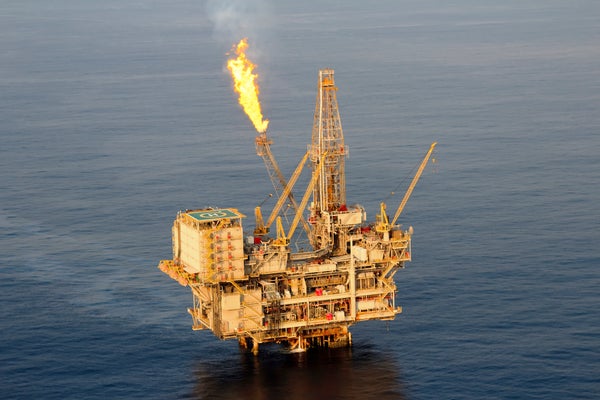Most plans to tackle climate change revolve around cutting down on carbon dioxide, usually by reducing human emissions.
But an unconventional new idea could actually slow the progress of global warming by putting more carbon dioxide into the atmosphere—while removing a more potent planet-warming gas in the process.
In a comment published Monday in the journal Nature Sustainability, a group of climate and chemistry experts said methane should be focused on more in the fight against climate change. Methane persists for a much shorter time in the atmosphere than carbon dioxide but is a much more powerful climate-warming gas while it lasts.
On supporting science journalism
If you're enjoying this article, consider supporting our award-winning journalism by subscribing. By purchasing a subscription you are helping to ensure the future of impactful stories about the discoveries and ideas shaping our world today.
Capturing atmospheric methane and converting it into less potent carbon dioxide, using special materials and chemical catalysts, may be one way to reduce the warming potential of greenhouse gases in the air, the authors say.
The idea is not intended to be a replacement for cutting emissions, noted the comment’s lead author Rob Jackson, a climate and environmental scientist at Stanford University.
“The smartest thing to do is to keep methane and carbon dioxide from entering the atmosphere,” he said. “It’s just that emissions are still rising, and we need to think about other tools and approaches to fight climate change.”
Taking greenhouse gases back out of the atmosphere, in addition to reducing the emissions going into it, is a long-discussed idea among climate scientists and activists. But it has mostly centered on carbon dioxide up to this point.
The idea has typically focused on ways to suck CO2 out of the air and then store it away so it doesn’t leak back into the atmosphere—a process broadly known as “negative emissions.” The net result would be a lower total concentration of carbon dioxide in the atmosphere.
Scientists have proposed a variety of ways to pull it off, from huge forests full of carbon-guzzling trees, which naturally soak up carbon dioxide, to special machines that would suck CO2 directly out of the air. In the latter scenario, the captured carbon dioxide would then have to be permanently stored away somewhere, likely by injecting it deep into the Earth.
There’s been much less focus on capturing methane, likely in part because the process is more technically difficult than capturing carbon dioxide. But scientists have some ideas about how it could be done.
The new comment proposes a promising method that involves the use of porous minerals called zeolites. Scientists already use zeolites to capture methane and convert it into methanol, an alcohol that can be used in chemical feedstocks or other industrial applications.
It’s not much more chemically complicated to convert the methane to carbon dioxide instead, Jackson pointed out. Once the conversion has taken place, the most cost-effective action would be to simply release the carbon dioxide back into the atmosphere. It does mean that more CO2 ends up in the air, but because it’s taking the place of a more potent greenhouse gas, the immediate effect is to lessen the progress of global warming.
Currently, the concentration of methane in the Earth’s atmosphere is hovering around 1,866 parts per billion. Before the industrial era, when human emissions of greenhouse gases began to skyrocket, methane levels were closer to 750 ppb.
Restoring the atmosphere to its preindustrial methane concentrations would produce about 8 billion tons of carbon dioxide in the conversion process, Jackson and colleagues note. That’s the equivalent of a few months’ worth of present-day global carbon dioxide emissions. Currently, the world emits about 40 billion tons of carbon dioxide each year.
“It’s not trivial, but it’s not a deal breaker,” Jackson said.
Because the concept is almost entirely hypothetical for the moment, it’s difficult to outline all the conditions that would be required to develop it and bring it up to scale.
When it comes to direct air capture of carbon dioxide—its closest existing analog—the costs of deploying the technology and the challenges to developing a market for it are some of the biggest hurdles. Experts have pointed out that federal incentives may be necessary for corporations to consider it worthwhile to invest in the technology. That could mean anything from a tax on carbon emissions to a subsidy for carbon removal.
The same is likely to be true for methane conversion, the authors of the new comment suggest, noting that “a price on carbon emissions or a policy mandate would be required” for the process to become economically attractive. Under such a scenario, though, they note that methane capture could become even more attractive than carbon dioxide capture—the price on methane would likely be higher because it’s a more potent greenhouse gas than carbon dioxide.
Those are all details that remain to be debated. For now, the idea is just a concept—but it’s one that some experts say could potentially add a new tool to the arsenal of weapons against climate change.
“We should be looking at the options for removal of all the major greenhouse gases,” David Victor, a climate and energy policy expert at the University of California, San Diego, said in an emailed comment to E&E News. “After CO2, methane is the next leading candidate.”
Reprinted from Climatewire with permission from E&E News. E&E provides daily coverage of essential energy and environmental news atwww.eenews.net.
